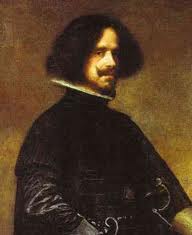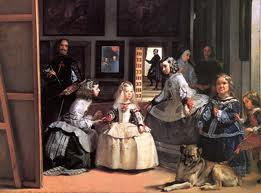Baroque: Diego Velázquez
Diego Velázquez was one of the most famous Spanish painters of the Golden Age, whose repertoire consisted in paintings of the Spanish Royal family and religious scenes. His paintings from the contemporary Baroque period, exhibit both the Impressionist and Realist genres of art. Some of his greatest paintings include 'Cristo Crucifado' (1632), the portrait of Pope Innocent X (1650) and 'Las Meninas' (1656).
Diego Velázquez (1599-1660)

Diego Velázquez was born and studied in Seville, Spain, where he learnt languages and philosophy. Velazquez displayed talent for art at a young age and therefore he began to study with Francisco de Herrera. He then studied in Seville for a further five years under the influence of Francisco Pacheco, another Spanish artist. Later, Velázquez married his former teacher's daughter, Juana Pacheco, with whom he had two daughters. Only one survived into adulthood.
At the end of 1622, the current Royal painter, Rodrigo de Villandro, passed away which left the way clear for Velázquez. A portrait of the King was ordered in 1623. The portrait Velázquez painted sufficiently impressed the King and so he requested that Velázquez move to Madrid in order to become the Royal Court painter.
Although Velázquez painted many Royal paintings, many of them were lost. The Museo del Prado in Madrid does however have two of the portraits of King Philip IV that Diego Veláquez painted in its collection.
Apart from the King, Velázquez also painted other members of the Spanish Royal family including the King´s wife, Elisabeth of Bourbon and her son, Don Baltasar Carlos. He also painted many portraits of people from the upper Spanish classes in Spain such as soldiers, clergymen and poets.
In 1649, Diego Veláquez and his manservant took a trip to Italy, which was sponsored by King Philip IV. Velázquez travelled through Italy buying paintings along the way. He eventually ended up in Rome where he was met by the Pope, who greeted him by presenting him with a gold chain and medal. He then painted his famous portrait of the Pope, which was considered to be one of the finest portraits in Italy at the time. It was so good that even Velázquez wanted a copy of it, and so he took a copy with him back to Spain. Today there are many different copies and replicas of this portrait in galleries across the world.

'Las Meninas' (The Maids of Honour) is without doubt one of this Spanish painter's most famous works. It is celebrated for being an intriguing picture with many mysteries. The focus of the picture is unclear as there is a lot going on in both the foreground and the background.
The subject of 'Las Meninas' is most likely to be the eldest daughter of the King and Queen, yet Velázquez has included himself to the left hand side of the painting which draws attention away from the girl. Also, the King and Queen are depicted looking at the easel from a reflection in the mirror, as though they are the audience of the painting, looking at 'Las Meninas' like one would in a gallery.
All of these different aspects which play with the mind of the audience of the painting mean that 'Las Meninas' by Diego Velázquez is considered to be one of the greatest examples of European Baroque Art.
This painting was so influential that it led Picasso to recreate it 58 times with his cubist style in the 1950s. It is said also that Salvador Dali took the inspiration for his famous moustache from that of Diego Velázquez.
Diego Velázquez died in 1660 after having suffered a fever. Velázquez was buried in the Fuensalida Vault of the church of San Juan Bautista. However, the church was destroyed by the French in 1811. This means that the final resting place of Diego Velázquez remains a mystery.
